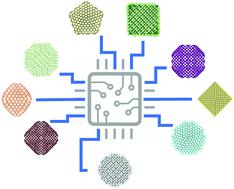当前位置:
X-MOL 学术
›
Nanoscale Horiz.
›
论文详情
Our official English website, www.x-mol.net, welcomes your
feedback! (Note: you will need to create a separate account there.)
Machine learning reveals multiple classes of diamond nanoparticles.
Nanoscale Horizons ( IF 8.0 ) Pub Date : 2020-08-20 , DOI: 10.1039/d0nh00382d Amanda J Parker 1 , Amanda S Barnard
Nanoscale Horizons ( IF 8.0 ) Pub Date : 2020-08-20 , DOI: 10.1039/d0nh00382d Amanda J Parker 1 , Amanda S Barnard
Affiliation

|
Generating samples of nanoparticles with specific properties that allow for structural diversity, rather than requiring structural precision, is a more sustainable prospect for industry, where samples need to be both targeted to specific applications and cost effective. This can be better enabled by defining classes of nanoparticles and characterising the properties of the class as a whole. In this study, we use machine learning to predict the different classes of diamond nanoparticles based entirely on the structural features and explore the populations of these classes in terms of the size, shape, speciation and charge transfer properties. We identify 9 different types of diamond nanoparticles based on their similarity in 17 dimensions and, contrary to conventional wisdom, find that the fraction of sp2 or sp3 hybridized atoms are not strong determinants, and that the classes are only weakly related to size. Each class has been describe in such way as to enable rapid assignment using microanalysis techniques.
中文翻译:

机器学习揭示了多类钻石纳米颗粒。
产生具有特定性质的纳米颗粒样品的目的是允许结构多样性而不是要求结构精度,这对于工业来说是更可持续的前景,在工业中,样品既需要针对特定应用,又要具有成本效益。通过定义纳米粒子的类别并表征整个类别的属性,可以更好地实现这一点。在这项研究中,我们使用机器学习来完全基于结构特征预测钻石纳米颗粒的不同类别,并从大小,形状,形态和电荷转移特性方面探讨这些类别的种群。基于它们在17个维度上的相似性,我们确定了9种不同类型的钻石纳米颗粒,并且与传统观点相反,发现sp 2或sp3个杂原子不是强决定因素,并且类别仅与大小弱相关。每个类别的描述方式均允许使用微量分析技术进行快速分配。
更新日期:2020-09-28
中文翻译:

机器学习揭示了多类钻石纳米颗粒。
产生具有特定性质的纳米颗粒样品的目的是允许结构多样性而不是要求结构精度,这对于工业来说是更可持续的前景,在工业中,样品既需要针对特定应用,又要具有成本效益。通过定义纳米粒子的类别并表征整个类别的属性,可以更好地实现这一点。在这项研究中,我们使用机器学习来完全基于结构特征预测钻石纳米颗粒的不同类别,并从大小,形状,形态和电荷转移特性方面探讨这些类别的种群。基于它们在17个维度上的相似性,我们确定了9种不同类型的钻石纳米颗粒,并且与传统观点相反,发现sp 2或sp3个杂原子不是强决定因素,并且类别仅与大小弱相关。每个类别的描述方式均允许使用微量分析技术进行快速分配。











































 京公网安备 11010802027423号
京公网安备 11010802027423号